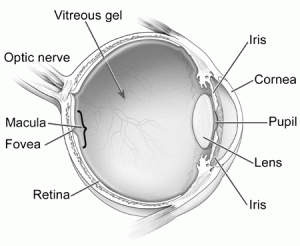Diabetic retinopathy is part of a group of eye complications named diabetic eye disease, which also includes cataract (clouding of the eye’s lens) and glaucoma (increase in fluid pressure in the eye that leads to optic nerve damage and loss of vision). Diabetic retinopathy is the most common diabetic eye disease and is caused by damage to the blood vessels in the retina. It is the most common cause of blindness of adults in the USA and the UK.
What is the retina?
The retina is the light-sensitive layer of cells at the back of the eye (see picture below), which converts light into electrical signals which are sent to the brain via the optic nerve, where it is “translated” into images we see.

What causes diabetic retinopathy?
High blood glucose levels are the main cause of retinopathy, but high blood fats and high blood pressure can also contribute. Smoking also plays a part in eye damage. All of these can damage blood vessels all over the body, but small and delicate blood vessels such as those supplying the retina are especially susceptible to damage. When blood vessels supplying the retina become damaged (leak, become blocked or grow abnormally), the retina cannot function properly and that causes the blurry vision, spots in your vision (that sometimes come and go) or even blindness.
Everyone with diabetes (all types) is at risk. A large percentage of people diagnosed with diabetes have some stage of diabetic retinopathy, therefore it is very important to be aware and get regularly examined.
What types of retinopathy are there?
There are three main types of retinopathy:
- Background or non-proliferative diabetic retinopathy- the earliest visible change to the retina, which does not affect the eyesight. Small blood vessels in the retina become blocked, causing micro aneurysms (small bulges) and may leak blood or other fluid.
- Maculopathy or macular edema- occurs when background retinopathy happens in or around the macula (see eye diagram). It can happen at any stage of background retinopathy, and disturbs central vision needed for precise sharp vision. Fluid leaking into the macula causes it to swell, leading to blurry vision and problems in seeing fine details.
- Proliferative retinopathy- this stage occurs as retinopathy develops and large areas of the retina do not receive proper blood supply, stimulating growth of new blood vessels in an attempt to compensate. These blood vessels are abnormal and fragile, and if they leak blood, scar tissue may form leading to eventual detachment of the retina and possible vision loss and blindness.
How can diabetic retinopathy be treated?
If you have diabetic retinopathy, ask your doctor which type of treatment is the best fit. Timely and adequate treatment can greatly reduce the chances of vision loss.
- Laser treatment- The tiny laser burns small areas in the retina, improving the blood flow and destroying abnormal new blood vessels. It is a relatively simple procedure that has greatly improved retinopathy treatment, reducing the risk of future blindness by up to 90%. It is usually used when macular edema occurs or in the stage of proliferative retinopathy.
- Anti-VEGF injection- this treatment is used for macular edema. VEGF, or vascular endothelial growth factor, is produced by the retina to increase blood vessel growth, and is activated when blood vessels are blocked or damaged. Anti-VEGF treatment blocks this growth factor, inhibiting abnormal blood vessel growth.
- Steroids- A small implant is inserted into the affected eye to treat vision loss associated to macular edema which has not responded to other treatments. The implant releases low-dose and long-acting steroids over a period of approximately three years.
- Vitrectomy- This major procedure is performed when a hemorrhage does not clear for several weeks or in advanced proliferative retinopathy. During the procedure the vitreous gel clouded by blood (see eye diagram) is removed and replaced with a clear substance.
How can I protect my vision?
- If you have diabetic retinopathy, you might not notice changes to your vision at first. Therefore it is very important to get a comprehensive dilated eye exam at least once a year. Go to your doctor immediately if you notice any changes in your vision.
- Whether or not you have symptoms, your eye care professional can tell if you have any stage of retinopathy. Early detection and timely treatment can prevent vision loss.
- Try to control blood sugar levels as indicated by your healthcare team, this slows the onset and progression of retinopathy and lowers the need for laser surgery.
- Try and follow indications by your healthcare team regarding medication, diet and weight loss.
- If you smoke, try to reach out to get help to quit.
This is general information about diabetic retinopathy, it is very important to see your eye care professionals regarding your specific condition, as they have examined your eyes, are familiar with your specific condition and can best answer any question you may have. But remember- retinopathy is treatable and vision loss can be avoided!
-By Liran Julia Grunhaus
Learn how to thrive with diabetes with our all-in-one personalized smart glucose meter.
learn more about diabetes management www.mydario.com







